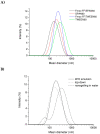Stable Formulations of Peptide-Based Nanogels
- PMID: 32751321
- PMCID: PMC7435922
- DOI: 10.3390/molecules25153455
Stable Formulations of Peptide-Based Nanogels
Abstract
Recently, nanogels have been identified as innovative formulations for enlarging the application of hydrogels (HGs) in the area of drug delivery or in diagnostic imaging. Nanogels are HGs-based aggregates with sizes in the range of nanometers and formulated in order to obtain injectable preparations. Regardless of the advantages offered by peptides in a hydrogel preparation, until now, only a few examples of peptide-based nanogels (PBNs) have been developed. Here, we describe the preparation of stable PBNs based on Fmoc-Phe-Phe-OH using three different methods, namely water/oil emulsion (W/O), top-down, and nanogelling in water. The effect of the hydrophilic-lipophilic balance (HLB) in the formulation was also evaluated in terms of size and stability. The resulting nanogels were found to encapsulate the anticancer drug doxorubicin, chosen as the model drug, with a drug loading comparable with those of the liposomes.
Keywords: diagnostic imaging; doxorubicin; hydrogel nanoparticles; inverse emulsion; nanogel formulation; peptide aggregates; peptide-based nanogels.
Conflict of interest statement
The authors declare no conflict of interest.
Figures






References
-
- Jayawarna V., Ali M., Jowitt T.A., Miller A.F., Saiani A., Gough J.E., Ulijn R.V. Nanostructured Hydrogels for Three-Dimensional Cell Culture Through Self-Assembly of Fluorenylmethoxycarbonyl–Dipeptides. Adv. Mater. 2006;18:611–614. doi: 10.1002/adma.200501522. - DOI
MeSH terms
Substances
LinkOut - more resources
Full Text Sources

